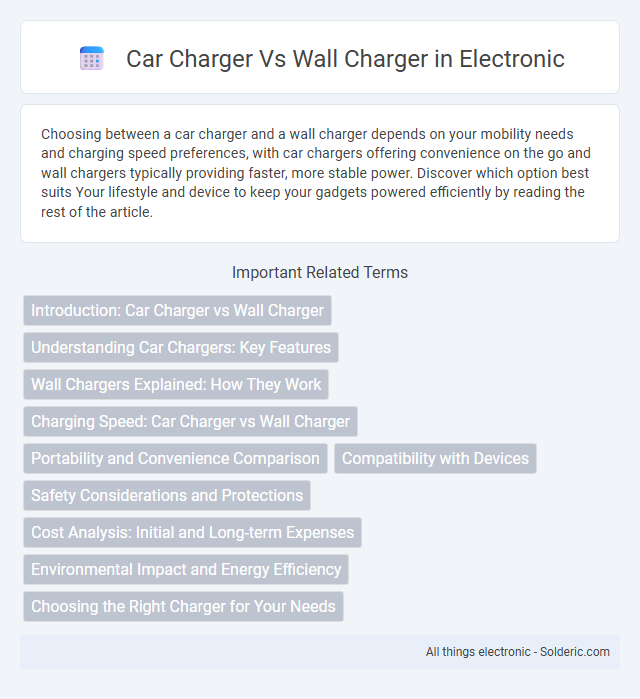Choosing between a car charger and a wall charger depends on your mobility needs and charging speed preferences, with car chargers offering convenience on the go and wall chargers typically providing faster, more stable power. Discover which option best suits Your lifestyle and device to keep your gadgets powered efficiently by reading the rest of the article.
Comparison Table
| Feature | Car Charger | Wall Charger |
|---|---|---|
| Power Source | 12V/24V car outlet (cigarette lighter) | AC power outlet (110V-240V) |
| Portability | Highly portable, ideal for travel or driving | Less portable, best for stationary use |
| Charging Speed | Typically slower, depends on car's output | Generally faster, supports higher wattage |
| Compatibility | Works for devices with USB or USB-C ports in vehicles | Universal for most USB, USB-C, or proprietary chargers |
| Use Case | Charging on the go during driving | Charging at home, office, or any AC power location |
| Power Output | Usually up to 12W-36W | Can range from 18W up to 120W or more |
| Installation | Plug and use, no installation needed | Plug into wall socket, may require adapter for regions |
| Price Range | Generally lower cost ($10 - $40) | Varies widely, typically $15 - $70+ |
Introduction: Car Charger vs Wall Charger
Car chargers provide convenience by allowing you to power your devices on the go using your vehicle's 12V socket, making them ideal for travel and emergencies. Wall chargers typically deliver faster charging speeds due to higher wattage output, ensuring your smartphone or tablet reaches full battery quickly when plugged into a standard electrical outlet. Choosing between a car charger and wall charger depends on your lifestyle needs, whether prioritizing mobility or charging efficiency.
Understanding Car Chargers: Key Features
Car chargers typically feature USB ports optimized for faster charging while on the go, often supporting Qualcomm Quick Charge or USB Power Delivery technologies. They are designed to operate from a vehicle's 12V or 24V DC power outlet, with built-in safety features like overcurrent protection and temperature control. Compact size and portability make car chargers essential for maintaining device battery life during travel or long commutes.
Wall Chargers Explained: How They Work
Wall chargers convert AC power from electrical outlets into DC power that safely charges device batteries, using built-in transformers and voltage regulators to ensure consistent current delivery. They offer higher wattage outputs compared to car chargers, enabling faster charging speeds for smartphones, tablets, and laptops. Integrated safety features like overcurrent protection and temperature control prevent damage during charging.
Charging Speed: Car Charger vs Wall Charger
Car chargers typically provide charging speeds ranging from 18W to 65W depending on the USB port and vehicle power output, making them suitable for on-the-go charging but often slower than wall chargers. Wall chargers, especially those with Power Delivery (PD) technology, can deliver up to 100W or more, supporting faster charging cycles for compatible devices. The charging speed difference is mainly influenced by power source stability and maximum wattage output, with wall chargers generally offering more consistent and higher power levels for rapid device charging.
Portability and Convenience Comparison
Car chargers offer superior portability, enabling users to charge devices on the go without reliance on electrical outlets. Wall chargers provide stable power supply ideal for home or office use but lack the mobility needed for travel. Comparing convenience, car chargers excel for in-transit charging, while wall chargers dominate in stationary environments.
Compatibility with Devices
Car chargers typically support USB-A and USB-C ports, providing compatibility with a wide range of smartphones, tablets, and portable devices, including Apple, Samsung, and other Android brands. Wall chargers often offer higher wattage and multiple ports, making them suitable for fast charging larger devices like laptops and tablets, while maintaining compatibility across USB standards. Choosing between the two depends on device type, power requirements, and usage environment, as wall chargers excel in home settings and car chargers prioritize portability and convenience on the go.
Safety Considerations and Protections
Car chargers often include built-in surge protectors and temperature controls to prevent overheating and voltage spikes caused by fluctuating car power supply, enhancing device safety during travel. Wall chargers typically feature advanced safety mechanisms like over-current, over-voltage, and short-circuit protection designed for stable electrical outlets, reducing the risk of electrical hazards at home or office. Choosing chargers with certifications such as UL, CE, or FCC ensures compliance with rigorous safety standards, making them reliable for consistent device protection.
Cost Analysis: Initial and Long-term Expenses
Car chargers typically have lower initial costs, ranging from $10 to $40, depending on power output and features, while wall chargers can cost between $20 and $80. Long-term expenses of car chargers include potential vehicle battery wear if used improperly, whereas wall chargers, especially smart ones, offer energy-efficient charging that may reduce electricity costs over time. Maintenance and replacement costs are generally lower for wall chargers due to their stable installation and consistent power supply.
Environmental Impact and Energy Efficiency
Car chargers typically consume more energy due to longer charging times and less efficient power conversion compared to wall chargers, which are designed to optimize energy use. Wall chargers often incorporate advanced technology that reduces power waste and lowers carbon emissions associated with electricity use. Choosing the right charger for your devices can significantly minimize your environmental footprint by improving energy efficiency.
Choosing the Right Charger for Your Needs
Car chargers offer portability and convenience for charging devices on the go, especially during travel or long commutes. Wall chargers deliver faster and more stable power output, making them ideal for regular home or office use where charging speed and efficiency are priorities. Assessing your charging habits and environment helps you select the charger that best suits your lifestyle and ensures your devices remain powered whenever you need them.
Car charger vs Wall charger Infographic

 solderic.com
solderic.com